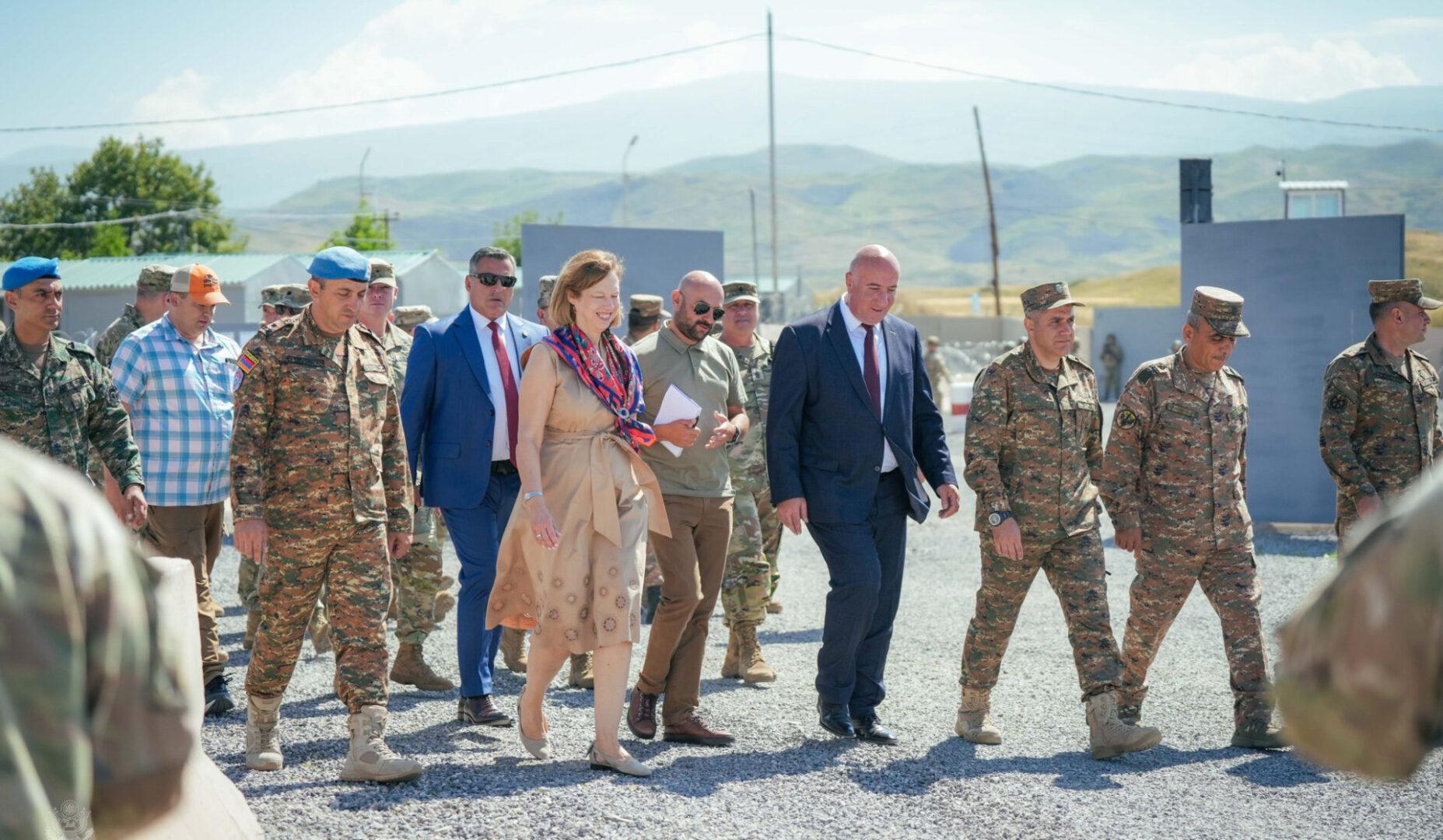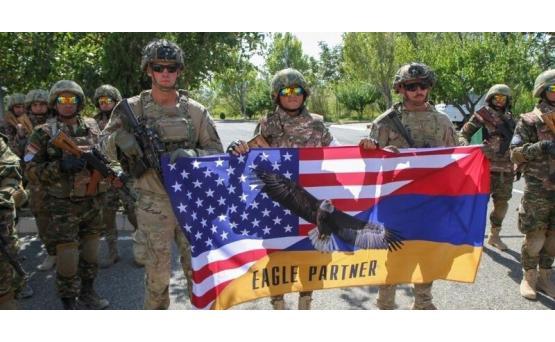US-Armenian military drills: Peacemaking or wake-up call? Stabilization cloaking aggravation
The US-Armenian military exercises, known as Eagle Partner 2024, concluded on July 24. This series of joint drills raises questions about the Biden administration's intentions in the South Caucasus. Rather than fostering lasting peace, the militarization of the region and the involvement of global superpowers may exacerbate existing tensions and lead to further destabilization.
Disputed peacekeeping effort
Armenia’s Defence Ministry has characterized Eagle Partner 2024 as purely “peacekeeping exercises.” The drills involved Armenia's peacekeeping brigade, the US Army's Central Command in Europe and Africa, and the Kansas National Guard. According to the Armenian Ministry of Defence, the exercises focused on improving interoperability among multinational coalition units, sharing best practices in command and control, and enhancing the combat readiness of Armenian forces.
The U.S. Embassy in Armenia detailed that the exercises aimed to develop peacekeeping skills through firearms training, stability operations, and range management activities.
The exercises were inaugurated on July 15 at the Military Academy, with significant attendees including Armenia's Defence Minister Suren Papikyan, US Ambassador to Armenia Christine Quinn, and Chief of General Staff Edward Asryan. The opening ceremony featured national anthems and a special anthem for Eagle Partner 2024.

While billed as peacekeeping training, the presence of US military forces and the scale of the exercises suggest a broader strategic aim. The increased militarization of Armenia and the involvement of Western powers could destabilize the region further rather than contribute to a peaceful resolution. The Biden administration's role in these activities prompts critical questions about its approach to the South Caucasus and the potential implications for regional stability.
Armenian Defence Minister Suren Papikyan has praised the recent US-Armenian military exercises, Eagle Partner 2024, stating, “I highly appreciate the work of the U.S. Army in Europe and Africa. I also express my gratitude to the servicemen of the Peacekeeping Brigade of the Armed Forces of the Republic of Armenia, representatives of the U.S. Embassy, and employees of the RA Ministry of Defence who participated in the effective planning of these exercises.”
While such expressions of gratitude seem part of the official protocol, they carry intriguing implications. The minister's high praise for the US Army’s role in Europe appears to conflict with Armenia's obligations to its CSTO allies, particularly Russia and Belarus.
Moreover, the remark about the US Embassy's involvement in planning military exercises raises questions. Traditionally, embassies are not tasked with planning such operations. Is it the role of an embassy, even a major one like that of the United States, to plan military exercises in the host country? It seems that the traditional concept of diplomatic missions is undergoing a significant transformation in our rapidly evolving global landscape. The appointment of Christine Quinn, a Master of Strategic Studies from the U.S. Army War College, as the US Ambassador to Armenia, seems quite logical.
“When I look at this parade ground and the large number of American and Armenian soldiers standing shoulder to shoulder in formation, it is very clear to me how much our bilateral cooperation has grown,” she stated at the opening ceremony.
Stabilizing conflicts
On July 16, training exercises commenced at the Zar base, the Armenian Army's 12th Brigade training facility, which was modernized in 2022 with U.S. support. The exercises included riot control, armed vehicle escorts, medical logistics, and checkpoint operations.
Notably, Armenian servicemen and U.S. National Guardsmen utilized Bastion APCs — French-made light armoured personnel carriers designed for reconnaissance, patrolling, and crowd control. The use of these vehicles indicates an emphasis on enhancing the Armenian army’s adaptability to foreign military equipment and improving its rapid mobility and response capabilities.
A significant aspect of the exercise was the logistical operations involving air transport. U.S. personnel and equipment were flown into Armenia by a C-17 Globemaster III, with around four flights conducted from Germany to Zvartnots airfield near Yerevan. This operation, part of the Strategic Airlift Capability (SAC) program — a consortium of 12 countries that jointly acquired three C-17 aircraft — highlighted the importance of efficient air logistics. Notably, U.S. crews managed to cut the unloading time of these heavy transports from the standard two hours to just 30 minutes, including unloading while engines were running.
Stryker armoured personnel carriers and a new Light Tactical Vehicle (JLTV) were also delivered to the US-Armenian exercise. In the Armavir area, Ghost Company, 2nd U.S. Cavalry Regiment, used this type of armoured vehicle to train for firing. The exercise also involved overcoming a ‘psychological barrier’ obstacle course (stress test) with simulations of real combat situations.
The drill involved the 12th Peacekeeping Brigade of the Armenian Armed Forces, the Kansas National Guard, the 2nd Cougar Squadron of the 2nd Cavalry Regiment, the 250th Military Intelligence Battalion of the U.S. Army, and the Heavy Air Wing (HAW) of the U.S. Air Force, based at Papa Air Base in Hungary. Soldiers from the 1st Cavalry Division and other units also took part. Some participants displayed patches combining the Armenian and U.S. flags, highlighting the close cooperation between the two nations.
Notably, the 2nd Cavalry Regiment, known for its elite status and historical significance, played a prominent role. Once known as the Stryker Regiment, it has transitioned from mounted to mechanized operations. The regiment’s storied past includes participation in the Iraq invasions of 1991 and 2003, and operations in Haiti, Bosnia, and Afghanistan. Currently stationed at Rose Barracks in Filseck, Germany, the regiment provides crucial liaison with NATO's Rapid Reaction Force in Europe and contributes to NATO's Expanded Forward Presence in Poland.
Adding to the international dimension, nine U.S. Army soldiers of Armenian descent from various branches — including the Marine Corps, Air Force, and the 319th Combat Operations Division of the U.S. Space Force — served as interpreters during the exercises.
The official narrative for the recent U.S.-Armenian military exercises, labelled as efforts to “stabilise the situation between conflicting sides,” might seem fitting on paper. However, the choice of Armenia as the exercise location is noteworthy. Unlike conflict zones such as Iraq or Syria, the South Caucasus, where these drills occurred, is itself a flashpoint of tension.
Armenia, a key participant in these exercises, is currently embroiled in regional disputes, including its recent involvement in the occupation of Azerbaijan’s Karabakh region. Given this context, the role of Armenia as a supposed "peacemaker" is contentious. The exercises, ostensibly aimed at stabilisation, might instead complicate the region’s delicate balance and raise questions about the true intent and impact of such military collaborations.
American curator for the Armenian army
Coincidentally or not, the US-Armenian exercises also partially coincided with the visit of US Deputy Secretary of State Uzra Zeya to Armenia, who visited some security agencies in Yerevan, which already receives humanitarian aid from America, and also held a meeting with the Secretary of the Armenian Security Council. Zeya also met with the Secretary of the Armenian Security Council, discussing Armenian-American cooperation, the "right of return" for Karabakh Armenians, and "the preservation of Armenian heritage in Karabakh".
Zeya announced that the Armenian Ministry of Defence will soon have an American advisor working within it. She described this development as a step towards a "new stage of strategic partnership" in Armenian-American relations.

According to Zeya, a U.S. Army representative will be assigned to work within the Armenian Ministry of Defence. It was later clarified that this advisor will be from the State Department, stationed in Yerevan, and their role will be funded through the U.S. Department of State's Global Defence Reform Programme.
Western news agencies have commented that Armenia, traditionally an ally of Russia, has strained relations with Moscow in recent years due to Russia's perceived failure to protect Armenia from Azerbaijan. These reports often overlook that it was Pashinyan and his administration who initiated the deterioration in relations with Moscow and Belarus. Azerbaijan did not attack Armenia but reclaimed its territories in line with international law. Russia and Belarus had no basis to intervene according to the CSTO charter or international legislation. Following its military defeat, the Pashinyan government has sought to shift the blame to Russia, leveraging the situation for information and political purposes.
Dangerous partnership
Armenia's cooperation with NATO began in 1993. In 2003, Armenia signed an agreement with the U.S. Department of Defense, establishing a special partnership with the Kansas National Guard. This collaboration has involved up to 30-40 events annually, significant financial aid, and the training of hundreds of Armenian officers. Despite being a member of the CSTO, Armenia is also part of the military coalition under the U.S. Army Central Command (CENTCOM).
Last year’s Eagle Partner 2023 exercise featured just 85 American and 175 Armenian soldiers. In contrast, the current U.S.-Armenian manoeuvres are significantly larger, both in terms of participants and territorial scope. Far from fostering stability, these exercises appear to jeopardize peace in the South Caucasus, deepening the divide between Armenia and Azerbaijan.
There are growing concerns that Washington’s current strategy is pushing Armenia into the role of a strategic outpost, potentially turning it into a military bridgehead that could destabilize the South Caucasus. The expanded scale of the recent U.S.-Armenian military exercises is seen by some as a move that threatens to escalate tensions in the region. This increased militarization may lay the groundwork for armed provocations against Azerbaijan and other neighbouring countries.
Furthermore, there is apprehension that the current strategy could foment not only national conflicts but also religious animosities. The risk is that Armenia might be used in a way that exacerbates divisions between Christian and Muslim countries, echoing the historical conflicts of the “crusades.” This approach mirrors past colonial policies that have led to disasters in other regions, such as the Middle East, and could be setting a similar path for the South Caucasus.
The exercises, codenamed "Eagle Partnership," feature an emblem with two eagles set against the Armenian and American flags. However, there are concerns that in reality, the disparity in power between the two nations could lead to a scenario where one side, much more dominant, might exploit the weaker partner. This dynamic raises fears that the weaker nation could suffer significant consequences as a result of this aggressive partnership.








